Advantages and Disadvantages of Ocean Thermal EnergyOcean Thermal Energy, also known as Ocean Thermal Energy Conversion (OTEC). Ocean thermal energy is the energy made possible by the temperature differential between the water at the ocean's surface and its deeper depths. In an OTEC power plant, electricity is produced from ocean thermal energy (OTEC power plant). 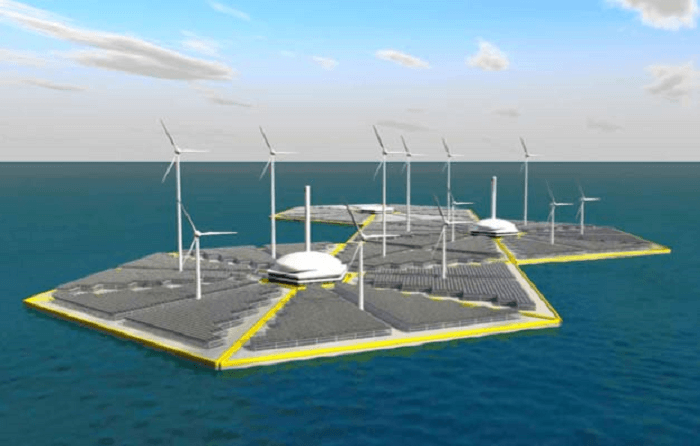
For these plants to function, there must be a 20°C temperature difference or greater between the surface water and deeper water. A liquid like ammonia or chlorofluorocarbon is boiled in the warm ocean surface water. The turbine of a generator is turned by the high pressure of liquid vapors, which then generates electricity. Types of Ocean Thermal Energy1. Closed-Cycle System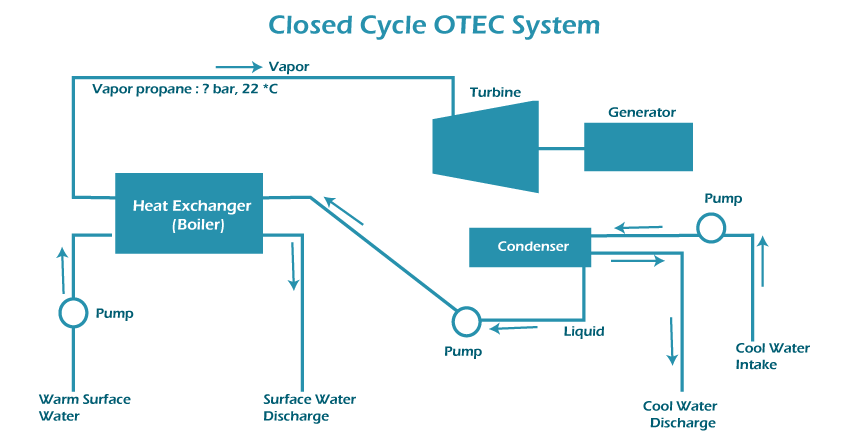
A turbine is powered by a fluid with a low boiling point, such as ammonia (which has a boiling point of about -33 °C at atmospheric pressure), in closed-cycle systems in order to produce energy. Pumping warm surface seawater via a heat exchanger causes the fluid to evaporate. Turbo-generators are powered by expanding vapour. By forcing the vapour through a second heat exchanger while using cold water, the vapour is changed into a liquid and the system is then circulated once more. The Natural Energy Laboratory and other partners from the corporate sector developed the "small OTEC" experiment in 1979, and it resulted in the first successful at-sea production of net electrical power from closed-cycle OTEC. The tiny OTEC vessel produced enough net electricity to run the ship's lights, computers, and television while it was moored 1.5 miles (2.4 kilometres) off the coast of Hawaii. 2. Open-Cycle System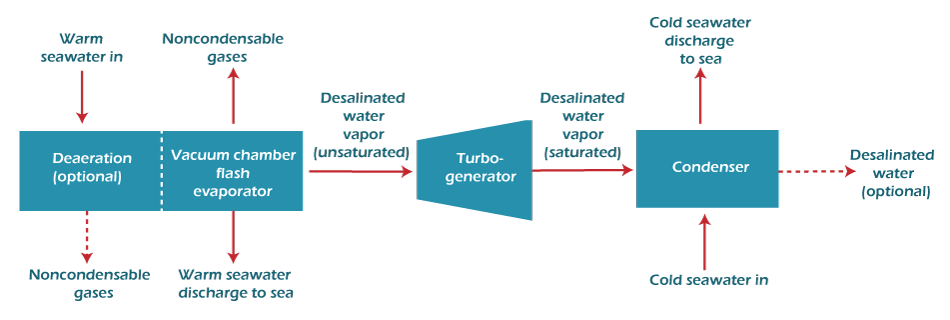
Open-cycle OTEC generates power straight from warm surface water. In order to get the warm seawater to boil, it is first pushed into a low-pressure vessel. In some plans, an electrical generator is connected to a low-pressure turbine that is driven by the expanding vapour. Pure fresh water is contained in the vapour, which has left its salt and other pollutants in the low-pressure container. By being exposed to the cold temperatures of deep ocean water, it condenses into a liquid. Desalinated fresh water that can be used for irrigation, aquaculture, or drinking is produced by this process. In some plans, the rising vapour is used in a gas lift technique to elevate water to substantial heights. Such vapour lift pump systems can either generate power from a hydroelectric turbine prior to either before or after the use of the pump, depending on the embodiment. The Solar Energy Research Institute (now the National Renewable Energy Laboratory) developed a vertical-spout evaporator in 1984 to convert warm saltwater into low-pressure steam for open-cycle reactors . Conversion efficiency for turning seawater into steam increased to 97%. (The total amount of steam produced would only be a small percentage of the water entering the system). An open-cycle OTEC plant in Keahole Point, Hawaii, produced roughly 80 kW of energy during a net power-producing trial in May 1993. This broke the previous record, 40 kW, achieved in 1982 by a Japanese system. 3. Hybrid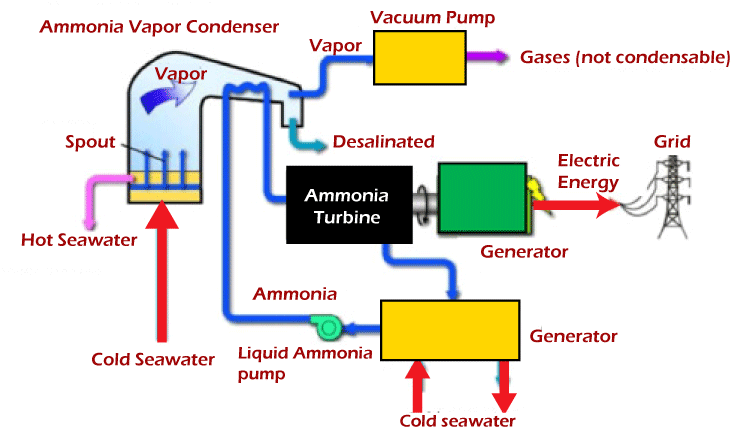
The advantages of both closed- and open-cycle systems are combined in a hybrid cycle. An open-cycle evaporation process-like flash vaporisation of warm seawater occurs in a vacuum chamber when warm seawater is introduced into a hybrid. A closed-cycle loop's ammonia working fluid is vaporised by steam on the side opposite an ammonia vaporizer.A turbine is then powered by the evaporated substance to generate electricity. Desalinated water is produced when the steam condenses inside the heat exchanger . Advantages of Ocean Thermal Energy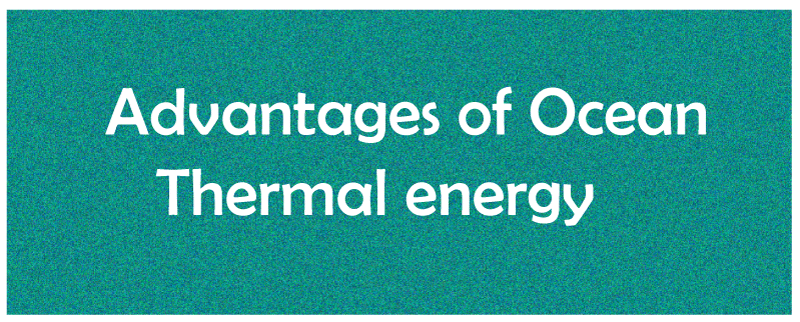
1. Renewable Energy OTEC is one of the various green energy options that are becoming more prevalent in certain of our nations. Oceans are fully available, and there is essentially no chance that they will ever run out. Additionally, there will nearly always be a variation in temperature between the ocean bodies. As a result, ocean thermal energy generation is sustainable. As a result, we can continue to produce electricity forever without the source running out. In the majority of countries, it is quite likely that fossil fuel consumption will one day be prohibited.As a result of the rising demand for energy supply, fossil fuels are being used up quickly.Fossil fuels, however, have dangerous effects on both humans and the environment, which we must recognise.Because of this, many people in our country are interested in producing electricity from environmentally friendly sources.Ocean thermal energy falls in this category. 2. Reliable Even while we can be inclined to get enthusiastic about the creation of renewable energy, some of the manufacturing techniques might turn out to be unreliable. Weather variations can affect the accuracy of electrical generation techniques like solar and wind power. Due to its low variability, ocean thermal energy is therefore regarded as a dependable source of energy. Therefore, companies that provide ocean thermal energy are not required to look for alternate ways to generate electricity. In contrast to solar and wind power, which may have reduced production during periods of inclement weather, this source of energy generation may not experience "low seasons." 3. Clean Energy We may have noticed that several nations are making green initiatives these days. This also applies to the creation of electrical power, not just the planting of trees. Future goals for many of our nations include the generation of clean energy. One of several sustainable energy sources is ocean thermal energy. Because the floating OTEC plants don't require any coal, natural gas, or other fossil fuels to operate, energy is produced on the sea. OTEC is now recognised as one of the technologies with the greatest promise for producing electricity in the future. 4. Low Maintenance Many of us would want to buy something that required little to no care and lasted for a long time. These characteristics exist in ocean thermal energy facilities. Once installed, the equipment takes little maintenance. Additionally, these floating OTEC plants require less staff to run, which makes them cost-effective. 5. Independent of Weather We can learn that ocean thermal energy power plants are located in the water. Only the top portion seems to be floating in the water.Since these plants are renowned to be all-weather and hurricane-proof, the weather has little impact on them. Additionally, since the plant depends on the temperature of the water between the surface and deep oceans, we can see it as a weather-independent source of renewable energy since it does not depend on solar or wind power. 6. Environmental-friendly Typically, ocean thermal energy facilities are placed in the water, far from populated areas. By doing this, it is made sure that the energy plant and the area's dense human population won't come into contact. Additionally, since no usage of fossil fuels is necessary for production, it improves the state of the environment, particularly the atmosphere. Therefore, when we use ocean thermal energy generation, we may breathe cleaner air. We may also find that this can be advantageous as we now know that the plant can ingest both cold and warm water. The deep cold water and nutrients found in the ocean's depths may also be pumped in by the pump.When these nutrients are released into surface water, they might improve the water's quality and offer areas for fishing. Disadvantages of Ocean Thermal Energy
1. High Initial Cost We can conclude that harnessing OTEC involves expensive equipment that must be purchased and installed. Considering that many of our countries currently have good living standards, only certain of them may be able to build ocean thermal energy facilities. The plant's setup might also call for a sizable workforce of experts. These services, which are very expensive, must also be taken into account while preparing the budget. 2. Locality of Production We discover that there are numerous acceptable locations for this energy harnessing, much like with other ocean energy producing techniques. Some coastal nations or even landlocked countries may find this to be a limiting factor. The idea behind ocean thermal energy makes use of the temperature gradient, and picking the optimum spot in the water is crucial for the best outcomes. But according to study, the temperature gradient created by the hot and cold seas mostly occurs in tropical areas. Therefore, many of our countries that are outside of this region might not profit from this kind of energy. 3. Small Temperature Difference There might not be much of a temperature difference between the deep waters and the surface seas. As a result, this can produce electricity with poor efficiency. Small power businesses that depend on this type of energy production may also find it to be quite expensive. Some of our electrical suppliers who use this method of energy production could need to get a "plan B" at the same time. This will serve as a backup power generation system to ensure that they can still provide electricity during periods of low efficiency. 4. Harmful Effects on Marine Life The deepest sections of the ocean are reached by pipelines from the ocean thermal energy plant. As a result, it is clear that these pipelines could affect marine life. Additionally, due to the power of the water's pumping, small aquatic animals may be drawn to the pipes. We discover that although the plant is environmentally favourable for the human population and the land, this may not be the case for the aquatic ecology. 5. Interferes with Navigation The ocean thermal plant has a lengthy, enormous construction under the surface even though it appears to be floating on the sea. Large ships may have trouble navigating around the floating body circle. Most of the time, we discover that some places where there might be ocean thermal energy plants also function as a route for these ships. Thus, obstructing their path or compelling the ships to seek alternate ways 6. Large Size Turbines with Expensive Liquid Large-sized turbines might be needed for the ocean thermal energy plant. It's important to know that these plants utilize big turbines since the pressure of boiling propene is so low. The restriction is when the cost of the turbines may be too high and prohibitive. Another item we should think about is the price of the propane. For some of our electricity-generating organizations, the cost of acquiring this liquid, which is used in the energy plant, may be high. ConclusionIn general, one of the relatively new energy production methods that are emerging nowadays is ocean thermal energy. In the future, the majority of our countries might decide to outlaw fossil fuels permanently. So, the possibility of resource depletion or the negative consequences that these fossil fuels have on our atmosphere may be to blame for the increase in this ban. There are many green energy resources available, which is fantastic news. The abundance of ocean water makes ocean thermal energy more efficient. But after weighing the benefits and downsides of this source of power, we can determine whether its advantages outweigh its negatives and whether some of our nations would be able to adopt it without experiencing serious setbacks. However, there is significant room for the growth and installation of ocean thermal energy in the future. People in today's society are welcoming green energy, and some of our nations have goals to reach for going green in the coming years. Investments in alternate energy sources will be made because we can't rely just on solar and wind energy. In any case, research indicates that ocean thermal energy can provide enough electricity for commercial use, which can support a nation's economic development.
Next TopicAdvantages and Disadvantages of Virus
|
 For Videos Join Our Youtube Channel: Join Now
For Videos Join Our Youtube Channel: Join Now
Feedback
- Send your Feedback to [email protected]
Help Others, Please Share










